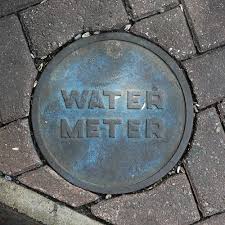Water

Water meters are read monthly on or about the 1st of the month:
Water usage read at the meter along with a factor to reconcile the difference between the amount billed by the city & the amount recorded at the meter is applied to each bill & the invoice is sent out via email. *No paper invoice will be mailed. The bill may be paid by mailing a check to the address listed on the bill or by following the link on the invoice & paying electronically.
*A bill is considered “late” when it has not been paid by the last day of the month. – all late invoices are subject to a 5% fee in addition to interest

Collections:
1- invoice is sent via email by the 10th of the month it is considered current until it ages past the 1st of the next month. *no paper invoice mailed
2- by the 10th of the month a statement is emailed listing the now past due invoice* no paper letter is sent
3- at about 60 days (the next month) a statement is emailed & a letter is mailed (U.S. mail) standard mail
4- at about 90 days (the next month) the account is turned over for collections & the attorney will mail via (certified mail) intent to lien & attorneys fees added
5- at about 120 days the a lien is filed & negative credit is reported to the credit bureau – the lien is not cleared until the account is brought current.
6- at about 150 days the foreclosure process is started
*late fees. Each month a bill is late it incurs a late fee of 5% & 1.5% interest continues to accrue along with any attorney/collection fees as incurred.
Protection-of Water System
This Article has been adopted to assist in protecting the safe drinking water supply of The
Pole Patch Landowners Association from the possibility of contamination or pollution by
requiring compliance with state and local plumbing codes, OSHA and other applicable
industry standards for water system safety within the Owner(s) private water system(s);
and to promote reasonable elimination or control of cross connection in the plumbing
fixtures and piping system(s) of the Owner, as required by state and local plumbing
codes, OSHA and other applicable industry standards to assure water system safety; and
to provide for the administration of a continuing program of back flow prevention which –
will systematically and effectively prevent the contamination of the drinking water
system due to unprotected connections.
It shall be the responsibility of the Owner to purchase, install, test and maintain any back
flow prevention device or assembly required complying with this Article.
No water service connection to any premises shall be installed or maintained by the
Owner or the Association unless the water supply is protected as required by State Laws,
regulations, plumbing codes, and-this Article. In the event an Owner’s water system is found to be in violation of this Article, service shall be discontinued by the Association if:
- A back flow prevention assembly required by this Article for control of back flow
and cross connections is not installed, tested, a11-d maintained, or
- If it is found that a back flow prevention assembly has been removed or bypassed, or c. If an unprotected cross connection exists on the premises, or d. If the ‘Owner causes that a periodic system survey has not been conducted as requested by the Association.
Service will not be restored until such conditions or defects are corrected.
The Owners system(s) shall be opened for inspection at all reasonable times to
authorized representatives of the Association to determine whether cross connections or
other structural or sanitary hazards, including violation of this Article exist and to audit the results of the required survey.
Whenever the Association deems a service connection’s water usage contributes a sufficient hazard to the water supply, an approved back flow prevention assembly shall be installed on the service line or the identified Owner’s water system, at or near the property line, or immediately inside the building being served; but, in all cases, before the first branch line leading off the service line (meter protection), or, as determined by the Association, an approved assembly or air gap may be installed in a manner that will isolate the cross connection from the Owner’s system. as well as the water system (isolation).
The type of protective assembly required above shall depend on the degree of hazard which exists at the point of cross connection (whether direct or indirect), applicable to local and state requirements or resulting from the required survey. All presently installed back flow prevention assemblies which do not meet the requirements of this section but were approved assemblies for the purpose described herein at the time of installation and which have been properly maintainet; shall, except for the inspection and maintenance requirements, be excluded from the requirements of these rules so long as the Association is assured that they will satisfactorily protect the Association’s water system. Whenever the existing assembly is removed from the present location or, requires more than minimum maintenance or, when the Association finds that the operation or maintenance of this assembly constitutes a hazard to health, the unit shall be replaced by an approved back flow prevention assembly meeting the local and state requirements.
If the Association determines that a cross connection violation or other violation of this
Article has occurred, service shall be discontinued to the Owner by providing a physical break in the service line. The Owner shall be liable for all of the expenses incurred by the Association to discontinue service, the expenses to remedy the violation and for all consequential damages caused thereby. Water services shall be withheld until such time that the Owner has come into compliance with the regulation of this Article, assumed responsibility for all expenses and damages that The Association has incurred or has made agreed arrangements to pay for the same.
Definitions, for purposes of this Article.
Approved Back flow Assembly or Device: Accepted by the Utah Division of Drinking Water, as meeting an applicable specification or as suitable for the proposed use. Back flow: The reversal of the normal flow of water caused by either back- pressure or back-siphonage.
Back Pressure: The flow of water or other liquids, mixtures, or substances under pressure into the feeding distribution pipes of a potable water supply system from any source(s) other than the intended source.
Back, Siphonage: The flow of water or other substances into the distribution pipes of a potable water supply system from any source{s) other than the intended source, caused by the reduction of pressure in the potable water supply system.
Back flow Prevention Assembly: Device: An assembly or means designed to prevent
back flow. ·specifications for back flow prevention assemblies are contained within the
currently adopted plumbing code for the State of Utah, and the Cross-Connection Control
Program for Utah.
Contamination: Degradation of the quality of the potable water” supply by sewage, industrial fluids or waste liquids, -compounds or other materials. Cross Connection: Any physical connection or arrangement of piping or fixtures which may allow non-potable water or industrial fluids or other material of questionable quality to come in contact with potable water inside a distribution system. This would include any temporary connections, such ‘:85 Swing connections, removable sections, four way plug valves, spools, dummy sections of pipe, swivel or change-over devices or sliding multi-port tubes of other plumbing arrangements.
Cross Connection – Controlled: A- connection between a potable water system and a non potable water system within an approved back flow prevention assembly properly installed arid maintained so that it will continuously afford the protection commensurate with the degree of hazard:
Cross Connection – Containment The installation of an approved back flow assembly at the water service connection to any Owner’s premises where it is physically and economically infeasible to find would permanently eliminate or control all actual or potential cross connections with the Owner’s water system; or, the installation of an approved back flow prevention assembly on the service line leading to and supplying a portion of an Owner’s water system where there are actual or potential cross connections which cannot be effectively eliminated or controlled at the point of the cross connection (isolation).
